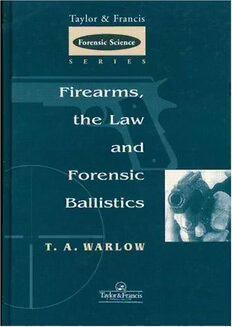
Forensic Speaker Identification PDF
Preview Forensic Speaker Identification
Forensic Speaker Identification i © 2002 Taylor & Francis Taylor & Francis Forensic Science Series Edited by James Robertson Forensic Sciences Division, Australian Federal Police Firearms, the Law and Forensic Ballistics T A Warlow ISBN 0 7484 0432 5 1996 Scientific Examination of Documents: methods and techniques, 2nd edition D Ellen ISBN 0 7484 0580 1 1997 Forensic Investigation of Explosions A Beveridge ISBN 0 7484 0565 8 1998 Forensic Examination of Human Hair J Robertson ISBN 0 7484 0567 4 1999 Forensic Examination of Fibres, 2nd edition J Robertson and M Grieve ISBN 0 7484 0816 9 1999 Forensic Examination of Glass and Paint: analysis and interpretation B Caddy ISBN 0 7484 0579 9 2001 ii © 2002 Taylor & Francis Forensic Speaker Identification Philip Rose London and New York iii © 2002 Taylor & Francis First published 2002 by Taylor & Francis 11 New Fetter Lane, London EC4P 4EE Simultaneously published in the USA and Canada by Taylor & Francis Inc, 29 West 35th Street, New York, NY 10001 Taylor & Francis is an imprint of the Taylor & Francis Group © 2002 Taylor & Francis Typeset in Times by Graphicraft Ltd, Hong Kong Printed and bound in Great Britain by TJ International Ltd, Padstow, Cornwall All rights reserved. No part of this book may be reprinted or reproduced or utilised in any form or by any electronic, mechanical, or other means, now known or hereafter invented, including photocopying and recording, or in any information storage or retrieval system, without permission in writing from the publishers. Every effort has been made to ensure that the advice and information in this book is true and accurate at the time of going to press. However, neither the publisher nor the author can accept any legal responsibility or liability for any errors or omissions that may be made. In the case of drug administration, any medical procedure or the use of technical equipment mentioned within this book, you are strongly advised to consult the manufacturer’s guidelines. British Library Cataloguing in Publication Data A catalogue record for this book is available from the British Library Library of Congress Cataloging in Publication Data A catalogue record has been requested ISBN 0-415-27182-7 iv © 2002 Taylor & Francis To my mum, who died on the day before she could see this book finished. To my dad, who taught me how to observe. v © 2002 Taylor & Francis Contents Acknowledgements 1 Introduction Forensic speaker identification Forensic phonetics Readership The take-home messages Argument and structure of the book 2 Why voices are difficult to discriminate forensically Between-speaker and within-speaker variation Probabilities of evidence Distribution in speaker space Multidimensionality Discrimination in forensic speaker identification Dimensional resolving power Ideal vs. realistic conditions Lack of control over variation Reduction in dimensionality Representativeness of forensic data Legitimate pooling of unknown samples Chapter summary 3 Forensic-phonetic parameters Types of parameters Acoustic vs. auditory parameters Traditional vs. automatic acoustic parameters Linguistic vs. non-linguistic parameters Linguistic sources of individual variation Forensic significance: linguistic analysis Quantitative and qualitative parameters Discrete and continuous parameters Requirements on forensic-phonetic parameters Chapter summary © 2002 Taylor & Francis 4 Expressing the outcome The likelihood ratio Combination of likelihood ratios Prior odds Alternative hypothesis Bayesian inference Pros and cons Pro-Bayesian arguments Anti-Bayesian arguments A reality check Chapter summary 5 Characterising forensic speaker identification Speaker recognition Speaker identification and verification Relationship between forensic speaker identification and speaker identification/verification Summary: Verification and identification Naive and technical speaker recognition Technical speaker recognition Conditions on forensic-phonetic speaker identification experiments Naive speaker recognition Naive speaker recognition: Discussion Familiarisation in auditory forensic analysis Aural-spectrographic (voiceprint) identification Linguistic controversy Legal controversy Summary: Aural-spectrographic method Chapter summary 6 The human vocal tract and the production and description of speech sounds The vocal tract The basic dichotomy Vocal cords Forensic significance: Vocal cord activity Summary: Vocal cord activity The supralaryngeal vocal tract Forensic significance: Nasals and nasalisation Squeezing the supralaryngeal vocal tract tube: Vowels and consonants Place and manner description of consonants Place of articulation English consonants Vowels Primary parameters of vowel description Secondary parameters of vowel description English vowels The componentiality of speech sounds © 2002 Taylor & Francis
